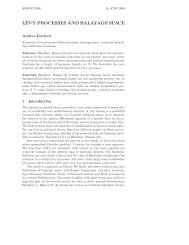Degenerate parabolic stochastic partial differential equations
Degenerate parabolic stochastic partial differential equations
Degenerate parabolic stochastic partial differential equations
You also want an ePaper? Increase the reach of your titles
YUMPU automatically turns print PDFs into web optimized ePapers that Google loves.
4330 M. Hofmanová / Stochastic Processes and their Applications 123 (2013) 4294–4336<br />
and the proof would be completed with ũ satisfying the kinetic formulation even in a stronger<br />
sense than required by Definition 2.2.<br />
In the case of martingales indexed by t ∈ D, we employ Proposition A.1 to conclude the<br />
validity of (45) for all ϕ ∈ Cc ∞(TN × R), t ∈ D, ˜P-a.s., and we need to allow a formulation<br />
which is weak also in time. Mimicking the technique developed in order to derive the kinetic<br />
formulation in Section 2, let us define<br />
N(t) = ˜ f 0 , ϕ +<br />
+<br />
t<br />
0<br />
t<br />
0<br />
˜ f (s), b(ξ) · ∇ϕ ds +<br />
<br />
δũ=ξ Φ(ũ) d ˜W , ϕ + 1 2<br />
t<br />
0<br />
t<br />
0<br />
˜ f (s), div A(x)∇ϕ ds<br />
<br />
δũ=ξ G 2 , ∂ ξ ϕ ds.<br />
Note, that N is a continuous real-valued semimartingale and<br />
N(t) = ˜ f (t), ϕ + ˜m, ∂ ξ ϕ ([0, t)), ∀t ∈ D.<br />
Next, we apply the Itô formula to calculate the <strong>stochastic</strong> <strong>differential</strong> of the product N(t)ϕ 1 (t),<br />
where ϕ 1 ∈ Cc ∞ ([0, T )). After the application of the Fubini theorem to the term including the<br />
kinetic measure ˜m, we obtain exactly the formulation (8). □<br />
4.5. Pathwise solutions<br />
In order to finish the proof, we make use of the Gyöngy–Krylov characterization of convergence<br />
in probability introduced in [16]. It is useful in situations when the pathwise uniqueness<br />
and the existence of at least one martingale solution imply the existence of a unique pathwise<br />
solution.<br />
Proposition 4.16. Let X be a Polish space equipped with the Borel σ -algebra. A sequence<br />
of X-valued random variables {Y n ; n ∈ N} converges in probability if and only if for every<br />
subsequence of joint laws, {µ nk ,m k<br />
; k ∈ N}, there exists a further subsequence which converges<br />
weakly to a probability measure µ such that<br />
µ (x, y) ∈ X × X; x = y = 1.<br />
We consider the collection of joint laws of (u n , u m ) on X u × X u , denoted by µ n,m<br />
u . For this<br />
purpose we define the extended path space<br />
X J = X u × X u × X W .<br />
As above, denote by µ W the law of W and set ν n,m to be the joint law of (u n , u m , W ). Similarly<br />
to Theorem 4.9 the following fact holds true. The proof is nearly identical and so will be left to<br />
the reader.<br />
Proposition 4.17. The collection {ν n,m ; n, m ∈ N} is tight on X J .<br />
Let us take any subsequence {ν n k,m k<br />
; k ∈ N}. By Prokhorov’s theorem, it is relatively weakly<br />
compact hence it contains a weakly convergent subsequence. Without loss of generality we<br />
may assume that the original sequence {ν n k,m k<br />
; k ∈ N} itself converges weakly to a measure<br />
ν. According to the Skorokhod representation theorem, we infer the existence of a probability<br />
space ( ¯Ω, F ¯ , ¯P) with a sequence of random variables (û n k<br />
, ǔ m k<br />
, ¯W k ), k ∈ N, converging almost<br />
surely in X J to a random variable (û, ǔ, ¯W ) and<br />
¯P (û n k<br />
, ǔ m k<br />
, ¯W k ) ∈ · = ν n k,m k<br />
(·),<br />
¯P (û, ǔ, ¯W ) ∈ · = ν(·).



